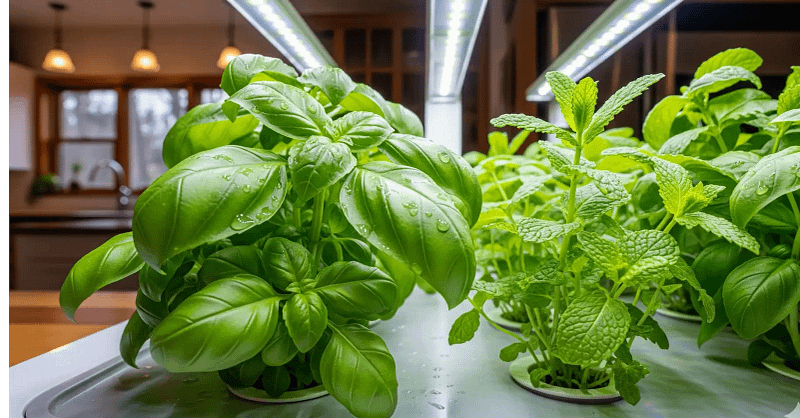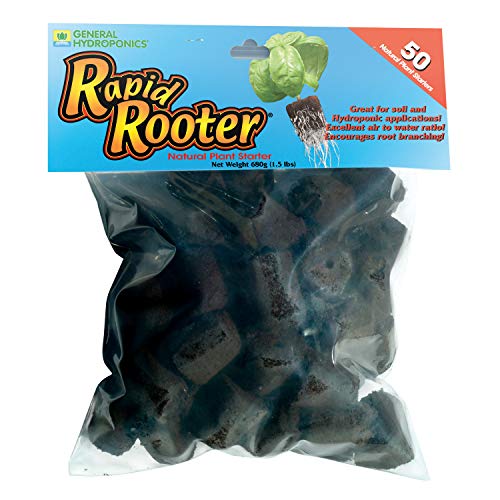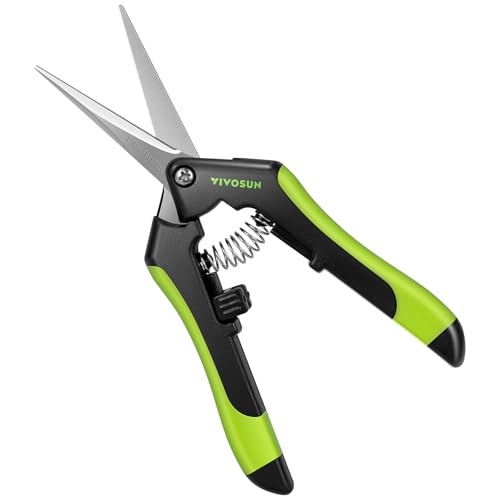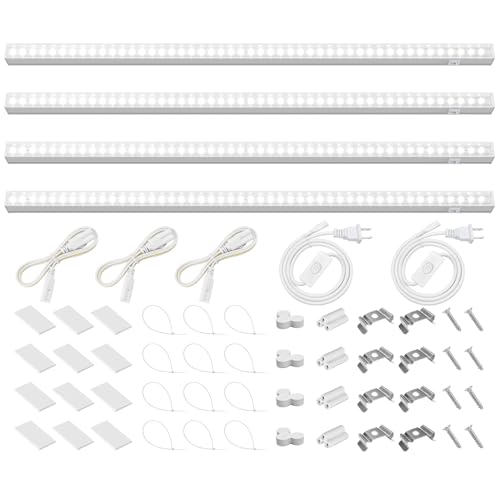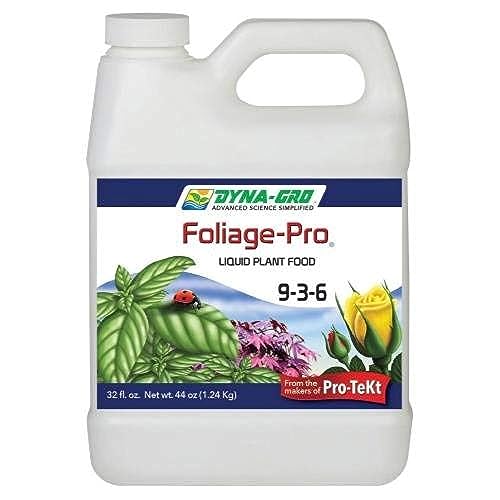Imagine this: It’s the dead of winter. The world outside is a muted canvas of grey and white, but in your kitchen, a vibrant, fragrant herb garden thrives under a gentle glow. You reach out, and a basil leaf releases a potent perfume of licorice and pepper. Another touch, and a mint leaf crackles, its frosty freshness promising a perfect mojito. Pesto in January? A garden-fresh mojito in February? This isn’t a fantasy. This is the reality of mastering hydroponic basil and mint.
The journey starts with a simple goal: to grow herbs so potent, so flavorful, that they elevate every dish they touch. But why do these two herbs, often grown together, have such distinct needs? And what secrets do professional chefs and commercial growers use to coax out their peak flavor? This isn’t just about survival; it’s about a sensory explosion. I’ve spent years getting my hands stained and my kitchen smelling like a trattoria, and I’m going to share everything I learned—including the glorious failures, like the time my entire mint crop tasted like toothpaste because of a simple mistake. It’s a journey of flavor, and you’re about to become the captain.
Legal Note: Some municipalities regulate indoor agriculture. Verify local compliance before you begin. This content is for educational and entertainment purposes only.
Why Soil Steals Flavor: The Dirty Little Secret
We’ve all had that moment. You buy “fresh” basil or mint from the grocery store, bring it home, and… it’s just a whisper. A pale imitation of the herb it’s supposed to be. There’s a reason for this, and it lies in the very medium we’ve been told is best: soil.
Think of it like this: soil is a crowded buffet. Nutrients are there, but they’re scattered, locked up, and often in a tug-of-war with other compounds. For an herb to get what it needs, its roots have to embark on a scavenger hunt. This struggle can slow growth, and more importantly, it dilutes the very compounds we cherish—the essential oils that give basil its punch and mint its zing.
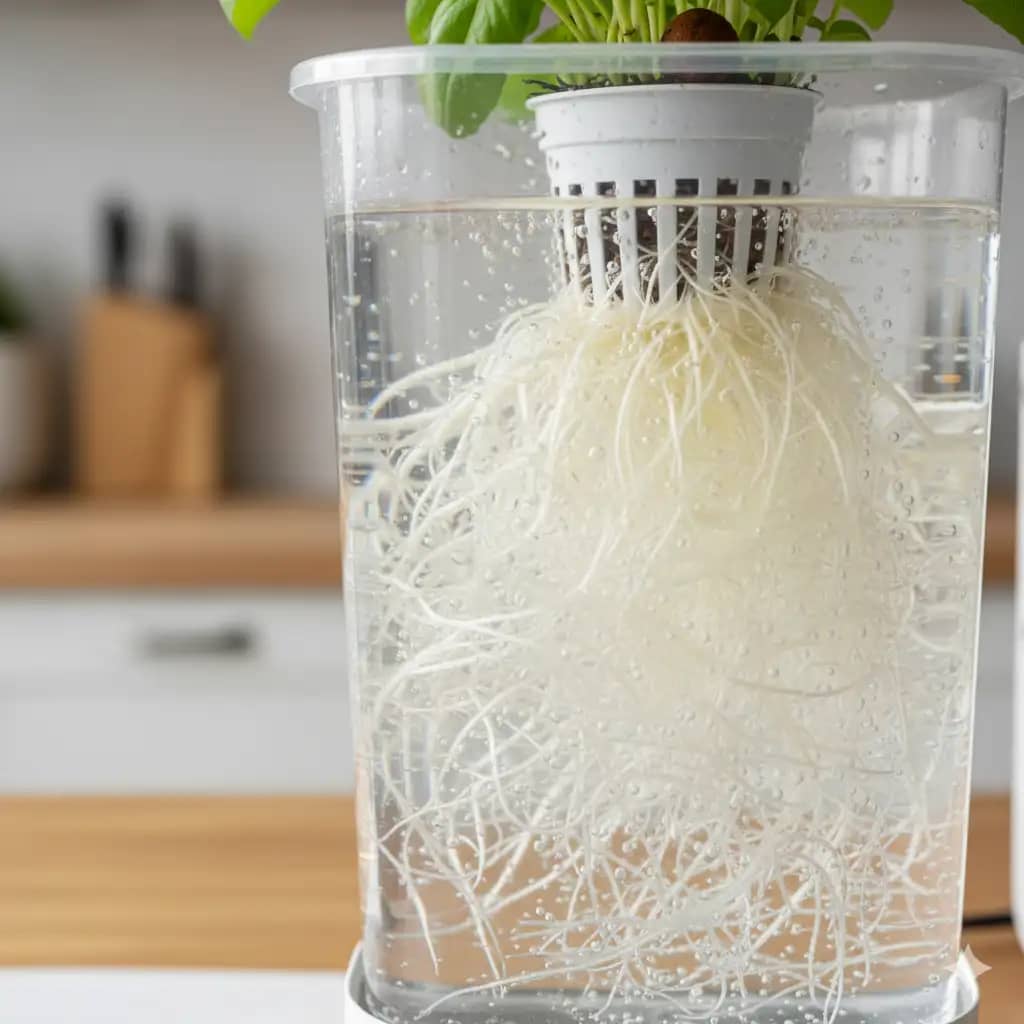
In hydroponics, the game changes entirely. The roots are bathed in a perfectly balanced, nutrient-rich solution. It’s a liquid spa where every essential element is instantly available. My basil, for example, produces essential oil concentrations up to twice as high as my soil-grown basil. Why? Because the plant doesn’t have to waste energy searching for food. It can dedicate all its resources to what matters most: growing vibrant, healthy leaves and producing those complex aromatic compounds. You’re not just growing herbs; you’re an alchemist, fine-tuning the inputs to maximize flavor output.
This is why my first mint crop tasted like toothpaste. I had the pH wrong, and the plant was starving for the right minerals, even though they were in the water. It was stressed, and that stress, instead of building character, turned the flavor bland and metallic. It took murdering about 100 plants to figure out that the “easiest” herb was a diva when it came to its root environment. Don’t worry, I’ll show you how to avoid my mistakes.
Basil Bootcamp: Taming the Queen of Herbs
My first love was basil. Its scent, a mix of peppery warmth and subtle licorice, can transport you to an Italian garden with a single sniff. But to get basil that truly sings, you need a different kind of boot camp. Basil is a heavy feeder and a sun-worshipper, so let’s start there.
Germination Magic: The Seed Whisperer’s Secret
Growing hydroponic basil from seed is a breeze, but there are a few tricks to get a strong start. Basil seeds love a little warmth. To get them sprouting quickly, you’ll want to maintain a germination temperature of about 75-85°F (24-29°C). I recommend a germination station with a heat mat. It makes a huge difference.
Once your seeds sprout in their rockwool cube, keep the nutrient solution very, very mild. A dilute solution with an EC of around 0.5-0.7 is perfect. You don’t need much, because a seedling is a bit like a newborn baby—it’s delicate and can get overwhelmed easily. Once the first set of true leaves appears, you can bump up the nutrient strength, but start low and go slow.
Grandma’s Secret #1: To ensure every seed sprouts, pre-soak your rockwool cubes in a dilute hydrogen peroxide solution (1 teaspoon of 3% hydrogen peroxide per gallon of water) for 30 minutes before planting. It sterilizes the cube and boosts oxygen for better germination.
The Perfect Light Recipe for an Oil Explosion
Basil is a sun-goddess. She craves light, and lots of it. For basil to develop its rich, complex essential oil profile, you need a high-quality light source. In my experience, a full-spectrum LED light is best for indoor setups. Aim for 12-16 hours of light per day.
You’ll know you have a good light setup when the leaves are a deep emerald green, almost shimmering. If the leaves are pale or seem to be stretching upwards toward the light, you need more intensity. But be careful—too much light can scorch the leaves, so find that sweet spot. My rule of thumb is a PPFD of around 200-400 µmol/m²/s.
Mint Mountain: A Guide to Unstoppable Growth
Mint is a different beast. Where basil is a heavy feeder with a delicate touch, mint is a boisterous, fast-spreading powerhouse. It’s the kind of herb that wants to take over everything, and you need to manage its wild energy to keep it productive and flavorful.
Propagation Pro-Tips: The 2-Week Root Hack
The easiest and most reliable way to start a mint crop is from cuttings. Simply snip a healthy stem just below a node, strip the lower leaves, and place it in a glass of water or, better yet, a dedicated propagation station. Within 7-14 days, you’ll see tiny white roots emerging from the node. Once the roots are a couple of inches long, they’re ready for their hydroponic home.
This method gives you an instant head start and ensures a genetic clone of a great-tasting mother plant. You bypass the sometimes-slow germination phase and get straight to the leafy growth..
Humidity Harmony: A Minty Oasis
Mint, unlike basil, thrives in cooler temperatures and a bit more humidity. It wants to feel like it’s growing by a cool stream. Ideal ambient temperatures are 65-70°F (18-21°C), but it’s the humidity that’s the real hero here. My best mint harvests came when I kept the humidity at a steady 60-70% during the vegetative stage. This is a crucial point for preventing powdery mildew, which we’ll discuss later.
Mint can handle a bit less light than basil. While 12-16 hours of LED light is great, it will perform just fine with as little as 6-8 hours of direct sun. I’ve seen it thrive in partial shade outdoors, so don’t be afraid to put it on a slightly less sunny shelf in your grow rack if you need to.
Basil vs Mint Cheat Sheet: A Quick Reference
| Factor | Basil | Mint |
| Ideal pH | 5.5-6.5 | 5.5-6.0 |
| Light Hours | 12-16 | 6-8 sun / 12-16 LED |
| Temp Range | 68-72°F (reservoir) | 65-70°F (air) |
| Key Nutrient | High Nitrogen (N) | Balanced NPK |
| Pruning Trigger | 6″ height | When leggy |
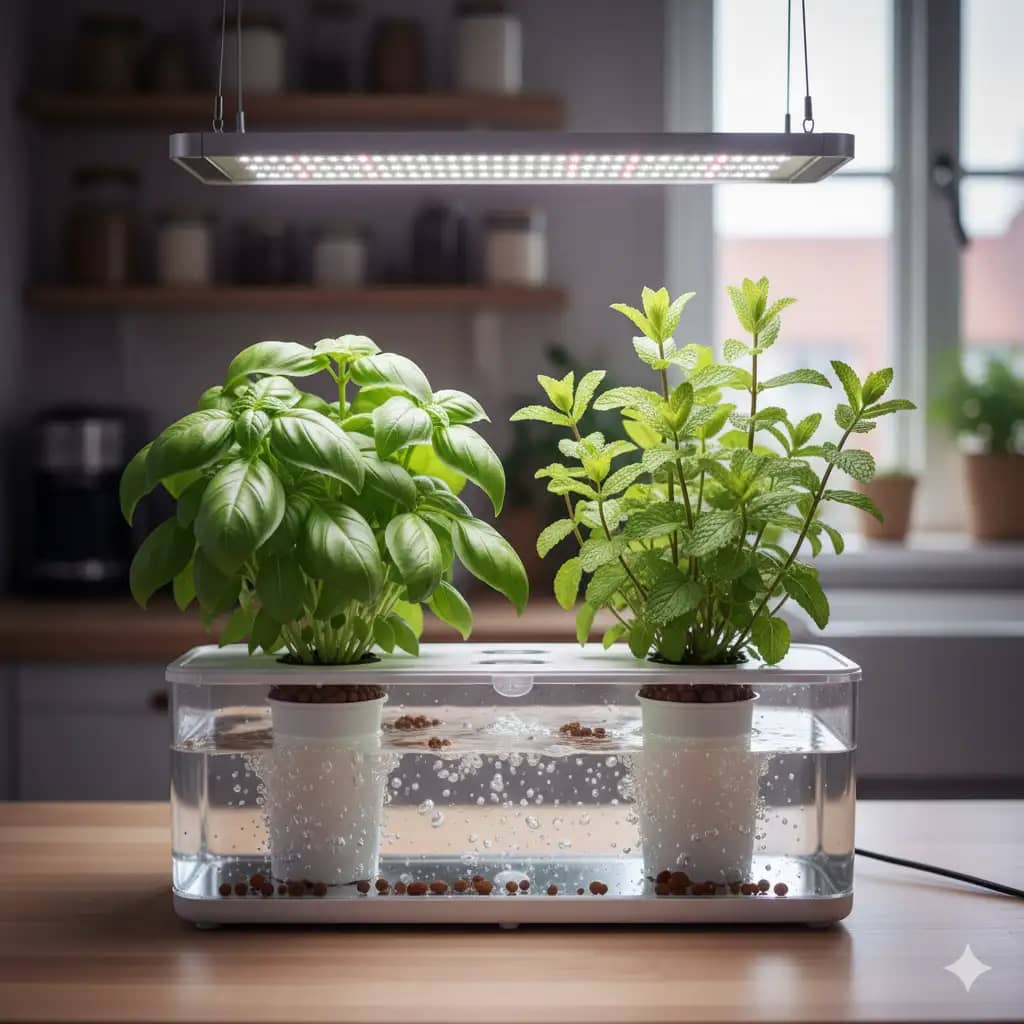
Shared Sanctuary: Cultivating Both in One System
The beauty of hydroponic farming is that you can often grow plants with similar needs in the same system. Basil and mint are perfect candidates for a shared garden, but you need to be a meticulous host. A basil plant is a guest who loves a party, but a mint plant is one who loves the whole house. They both thrive on fresh air and light, but their nutrient and pH needs are slightly different.
pH Perfection: The 5.5-6.5 Sweet Spot
This is the most critical part of growing anything hydroponically, and especially so for basil and mint. The pH of your nutrient solution dictates which nutrients the plants can actually absorb. If the pH is off, even a perfect nutrient mix is useless.
Basil prefers a slightly acidic environment in the 5.5-6.5 range. Mint is a bit more flexible and will do well in the same zone, though it can drift slightly lower. The key for a shared system is to aim for that golden middle: a consistent pH of 5.8-6.2. At this level, both plants can absorb all the essential minerals they need for vibrant growth.
Grandma’s Secret #2: Use a pH test kit or a digital meter daily for the first week to establish a baseline. You’ll find that as your plants grow, they’ll consume nutrients and shift the pH. Don’t panic. Gently adjust it with a pH Up or pH Down solution. Consistency is more important than minute, daily changes.
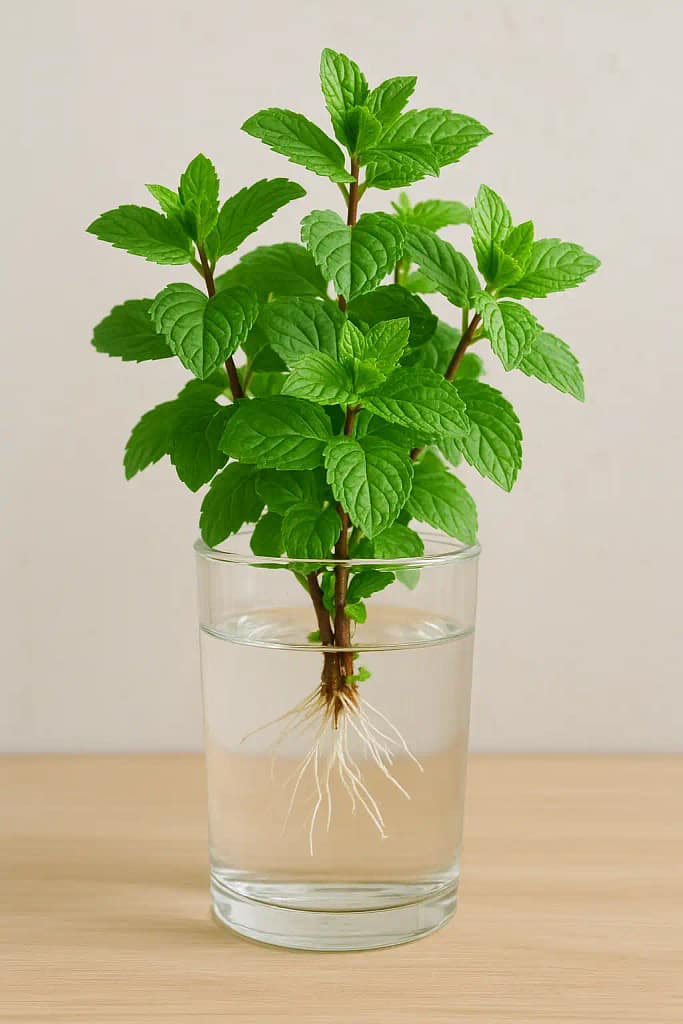
Nitrogen Nirvana: Fueling Leafy Growth
Both basil and mint are leafy greens, and leafy greens have one thing in common: they love nitrogen. A higher nitrogen (N) concentration is essential during their vegetative phase to support robust, green foliage. This is where the magic happens. A balanced NPK fertilizer with a higher N value, like a 2-1-2 ratio, is a great place to start for most vegetative growth stages.
If you see yellowing on older leaves, that’s a tell-tale sign of nitrogen deficiency. Too much nitrogen, on the other hand, can lead to thin, floppy stems. I’ve found that monitoring leaf color is a great way to gauge nitrogen levels—they should be a deep, healthy green.
Pruning for Abundance: The Art of the Harvest
This is the most satisfying part of the process. Pruning isn’t just about harvesting; it’s about shaping the plant for future success. It’s how you tell the plant, “Don’t go to seed. Don’t get leggy. Give me more beautiful leaves.”
The Basil “Cut & Come Again” System
To get a bushy, high-yield basil plant, you need to prune it regularly. My personal rule is to start pruning when the plant reaches about 6 inches tall. Find a node (the point where a new set of leaves is growing) and snip the stem just above it. This forces the plant to send energy to those lower nodes, creating two new branches where there was one. It’s like magic.
By doing this every week, you’ll create a thick, dense basil bush that looks like a miniature tree, and your pesto game will never be the same. The “cut and come again” method is key to preventing the plant from focusing its energy on flowering and going to seed, which makes the leaves bitter.
The Mint Legginess Fix
Mint is naturally a bit wild, but if you don’t keep it in check, it will get long, thin, and stringy. To prevent this, you should harvest it often. Don’t be shy! A vigorous pruning encourages the plant to fill out and bush up, giving you a thicker, healthier crop.
When you harvest mint, you can either pinch off the individual leaves or snip entire stems. I prefer to snip stems just above a node, leaving a few leaves behind. This encourages the plant to branch out, creating more stems and a fuller, more productive plant. Remember, mint thrives on this attention. It’s a plant that wants to be used.
Grandma’s Secret #3: For basil, keep an eagle eye out for flower buds. They look like small, central spikes with tiny green buds. Pinch these off the moment you see them. This small act tells the plant to stay in its vegetative state, ensuring all its energy goes into producing delicious, aromatic leaves instead of seeds.
War on Mildew & Rot: A Battle Plan
No one likes to talk about it, but every grower faces it. Fungal diseases and root rot are the twin terrors of the hydroponic garden. Powdery mildew can coat your leaves in a ghostly white, stealing light and flavor. Root rot turns your vibrant white roots into a slimy, foul-smelling brown mess. Both are a death sentence if not caught early.
The good news? They are preventable.
The Powdery Mildew Battle Plan: Powdery mildew thrives in warm, stagnant air and high humidity. My early failures were a testament to this. I battled it by focusing on three things:
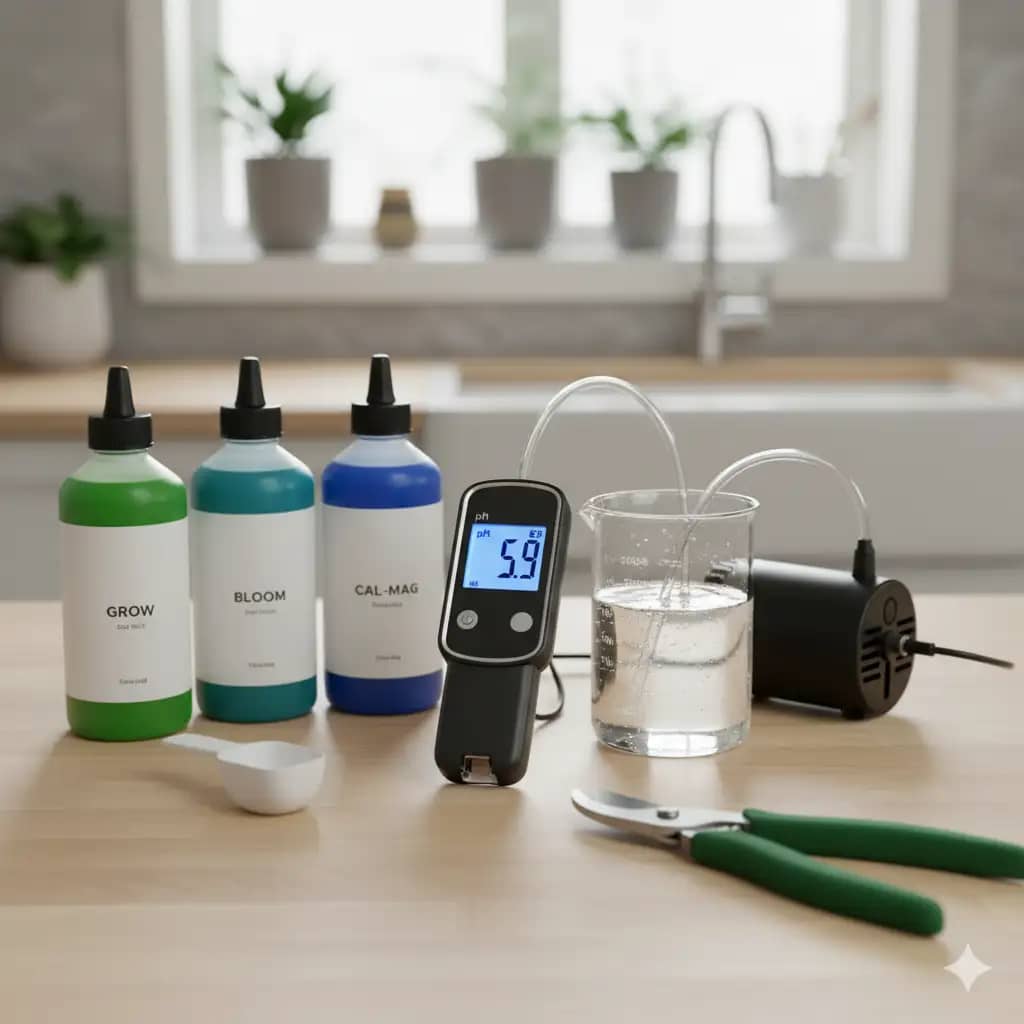
- Air Circulation: Use small clip-on fans to keep the air moving around your plants. This is a game-changer. It prevents moisture from sitting on the leaves and strengthens the plant stems.
- Environmental Control: Try to keep your humidity in the 40-60% range. If you notice a spike, a small dehumidifier can work wonders.
- DIY Antifungal Spray: A simple and effective solution is a baking soda spray. Mix one tablespoon of baking soda and a half-teaspoon of non-toxic liquid soap with a gallon of water. Spray your plants weekly, making sure to get the undersides of the leaves. It creates an inhospitable environment for the mildew.
The Root Rot Counter-Attack: Root rot (Pythium) is a different beast entirely. It’s caused by a lack of dissolved oxygen in your nutrient solution, which can be exacerbated by high water temperatures. The perfect storm for root rot is a warm, stagnant reservoir.
- Oxygen is Life: Use a high-quality air pump and air stone to vigorously bubble your nutrient solution. The more dissolved oxygen, the better. You can never have too much.
- Keep it Cool: Your reservoir temperature should be a crisp 68-72°F (20-22°C). In warmer climates, this is a challenge, but using a chiller can save your entire crop. A simple hack? Freeze a few water bottles and drop them in the reservoir to keep the temperature down.
- Sterilize, Sterilize, Sterilize: Every time you change your water, clean your reservoir and pump with a hydrogen peroxide solution. This kills any lingering pathogens.
Herb Gardener’s Toolkit: My Personal Recommendations
Every alchemist needs their tools. Here are the products and solutions I’ve used and stand by. These aren’t just things I’ve tried; they’re the gear that built my garden from the ground up, with a focus on ease-of-use and quality results.
Disclaimer: This section contains affiliate links. As an Amazon Associate, I earn from qualifying purchases. This helps keep the blog running and the tips flowing!
General Hydroponics Flora Series Performance Pack
This is a classic for a reason. The three-part system (Micro, Grow, Bloom) lets you mix custom ratios for every stage. It’s the most versatile option out there, and once you get the hang of it, you can dial in a perfect recipe for your plants. It’s the standard that many of us started with, and still rely on.
- The Flora Series is a hydroponic-based nutrient system that helps fulfill your plants’ nutrient needs at every stage of …
- Nutrients included in the Series are FloraMicro, FloraBloom, and FloraGro
- FloraMicro: contains nitrogen and calcium, as well as trace minerals, which are essential for a comprehensive hydroponic…
Why Growers Love It:
- Complete Nutrition: Three-part system provides precise control over each growth phase
- pH Stability: Buffered formulation minimizes pH drift in reservoir
- Strain Specific: Feeding charts available for various cannabis genetics.
Room for Improvement:
- Mixing Order: Requires specific mixing sequence to prevent nutrient lockout.
- Supplement Needs: May require additional PK boosters for heavy-feeding strains.
Bottom Line for Growers: The industry standard for reliability. Perfect for growers who want predictable results harvest after harvest. Check Price on Amazon.
Rapid Rooter Plant Starter Plugs, 50 Count
The ideal germination medium for starting basil and mint seeds, providing perfect moisture retention and aeration for strong root development .
- Rapid rooter plugs are fortified with general hydroponic micronutrients for abundant root growth
- The optimal air-to-water ratio within the plug matrix results in explosive early root growth
- Use rapid rooter for robust early rooting that supports explosive plant growth
Top-Shelf Features:
- Faster Germination: Promotes rapid sprouting of basil (3-10 days) and mint (10-15 days) seeds in optimal conditions .
- Seamless Transition: The plugs can be moved directly into most hydroponic systems, minimizing transplant shock.
- pH Balanced: Pre-adjusted to a neutral pH, providing a perfect environment for young seedlings.
A Word of Caution:
- Drying Out: Can dry out quickly under strong lights; requires monitoring to maintain consistent moisture.
- Size: The plug size may be too large for very small-scale propagation setups.
Who This Is For: Every herb grower starting from seed. It simplifies the most delicate stage of growth and sets your plants up for success . See Latest Discount.
VIVOSUN 6.5 Inch Gardening Hand Pruner
Sharp, precise pruning shears essential for the frequent harvesting required to keep basil and mint plants bushy and productive .
- Reduce Hand Strain: These micro tip snips are built spring-loaded so that they automatically push themselves open withou…
- Ultra Sharp Blades: These quality snips come with stainless steel precision-sharpened blades and are ready to tackle all…
- Secure, Easy to Lock: These micro tip snips feature a safe and secure sideways locking mechanism that keeps your blades …
Root-Level Benefits:
- Clean Cuts: Sharp blades make precise cuts without bruising delicate herb stems, preserving flavor and plant health .
- Promotes Bushing: Essential for the “cut and come again” method, encouraging basil and mint to grow full and bushy instead of tall and leggy .
- Comfortable Grip: Ergonomic handles reduce hand fatigue during frequent harvesting sessions.
Not a Perfect Fit For:
- Large Stems: Not designed for cutting very thick, woody stems that older mint plants can sometimes develop.
- Left-Handed Users: The design is optimized for right-handed use.
Our Grow-O-Meter Says: An indispensable tool for the herb gardener. Regular pruning is the secret to a continuous, bountiful harvest. Check Price on Amazon.
Barrina LED Grow Lights 2FT, 4-Pack
Full-spectrum T5 LED lights perfect for supplementing natural light for strawberries on shelves or in a greenhouse.
- 5000K Full Spectrum: Barrina T5 grow lights, offer the most reasonable grow light wavelengths based on the ratio of plan…
- High PPFD: This grow light strip with high PPFD maximize photosynthesis efficiency and promote rapid, healthy plant grow…
- 3-in-1 Installation: With included double-sided tape, clips and cable ties, you could easily install the led plant light…
The Green Thumb Upside:
- Full Spectrum: Provides the blue and red light spectra strawberries need for growth and flowering.
- Easy Installation: Daisy-chain design and included hanging kits make setup simple.
- Energy Efficient: Low profile and low heat output allow them to be placed close to plants.
Grower’s Notes:
- Coverage: This 4-pack is ideal for a single 2-ft x 4-ft shelf; larger areas need more lights.
- Intensity: Best for supplemental lighting; primary lighting for a large crop requires more powerful fixtures.
The Seedling Lowdown: The perfect, cost-effective solution for starting seedlings or boosting light for a small strawberry patch indoors or in a garage. See Latest Discount on Amazon.
Bluelab Combo Meter for pH, Temperature & Conductivity in Water
A professional-grade handheld meter that simultaneously monitors pH, conductivity (EC/TDS/PPM), and temperature in hydroponic solutions, ensuring precise nutrient management for optimal plant health.
- Monitor 3 parameters in water: Conductivity (TDS) level to ensure plants get a balanced feed, pH up and down, and temper…
- This hydroponics meter has ATC that provides consistent reading regardless of any fluctuations in temperature; pH probe …
- Combine with Bluelab meters and controllers for full indoor garden nutrients monitoring in water and soil; pH probe requ…
Why Growers Love It:
- Triple-Parameter Monitoring: Tracks pH, EC/TDS/PPM, and temperature simultaneously, eliminating the need for multiple devices and ensuring perfect nutrient balance.
- Lab-Quality Precision: Features automatic temperature compensation (ATC) and a double-junction pH probe for accurate readings despite environmental fluctuations.
- User-Friendly Design: Includes a backlit display, customizable units (EC, CF, PPM 500/700), and auto-off functionality to conserve battery life.
Room for Improvement:
- Probe Care Required: The pH probe requires regular calibration and proper storage (storage cap included, but care kit sold separately) to maintain accuracy.
- Initial Investment: Higher upfront cost compared to basic meters, but justified by long-term reliability and precision.
Bottom Line for Growers: The industry standard for serious hydroponic growers. Its lab-grade accuracy and durability make it indispensable for avoiding nutrient lockout and maximizing yields. Check Price on Amazon.
Yield Lab 48″x48″x78″ Hydroponic Grow Tent
A one-part nutrient solution specifically formulated for lush vegetative growth, making it an excellent choice for mint, which thrives on high nitrogen .
- High-quality foliage plant nutrient solution
- Specifically formulated for lush and healthy foliage growth
- Provides essential nutrients for green, leafy plants
The Green Thumb Upside:
- High Nitrogen Formula: Promotes the strong stem and leaf development that mint is known for, without encouraging flowering .
- Simplicity: A one-part solution makes nutrient mixing incredibly easy and foolproof.
- Complete Nutrition: Contains a blend of macro and micronutrients, so no additional supplements are needed.
Grower’s Notes:
- Not for Flowering: As it’s designed for foliage, it is not ideal for plants where flowering or fruiting is the goal.
- Mint-Specific: While great for mint, basil may still benefit more from a balanced two- or three-part system.
The Seedling Lowdown: An excellent, simple alternative nutrient specifically for mint growers who want to maximize vegetative yield . See Latest Discount on Amazon.
Conclusion: Your Green Kitchen Awaits
Hydroponic basil and mint are more than just a hobby; they’re an invitation to a fresher, more flavorful way of life. By understanding their unique needs and providing them with a little consistent care, you can unlock a culinary world that most people can only dream of. The key, as I’ve learned from countless harvests, is to be a meticulous observer and a patient guide. Master the pH, manage the pruning, and wage war on mold and rot—and you’ll be rewarded with a continuous, explosive supply of herbs that will change the way you cook.
This is a journey of trial and error, but with a little guidance, you’ll find that the rewards are worth every effort. Now that you’re armed with the secrets of the pros, what will your first hydroponic masterpiece be? A vibrant pesto? A refreshing mojito? The choice is yours.

